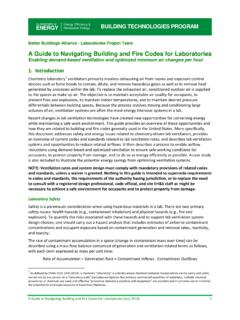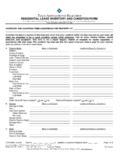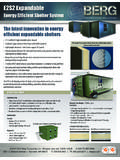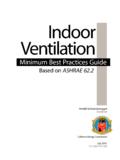Transcription of a b o r a t o r i e s f o r t h e 2 1 b e s t P r a C t i ...
1 L a b o r a t o r i e s f o r t h e 2 1 s t C e n t u r y : b e s t P r a C t i C e G u i d e M anifolding l aboratory E xhaust s ystEMs Introduction: Why Manifold? E ner g y E ffici en cy an d Ma ni fol ded Manifolding laboratory exhaust in laboratory build E xha u st ings provides substantial energy and first-cost savings A basic, manifolded exhaust system, with a primary opportunities when compared to separately ducted, mul fan and a backup unit in a common duct system, has tiple exhaust fans . A manifolded system also offers a num higher energy efficiency than multiple, dedicated fans ber of benefits, including: working independently. Manifolded exhaust systems Increased fume dilution save energy in four ways: Enhanced personnel safety 1.
2 Reduces fan power, in part due to less pressure drop in duct work. Augmented redundancy 2. Provides an adjustable airflow system that can modu Improved design flexibility late energy needs in response to a varying requirement. Probable energy recovery 3. Requires less energy to disperse exhaust plumes due Experience has shown that during laboratory retrofit to increased dilution and momentum of effluent. projects, manifolded exhaust systems reduce construction 4. Increases energy recovery opportunities. costs and help avoid operational disruptions. Even greater efficiency can be realized over a basic This best practice guide is one in a series created by manifolded arrangement when advanced design practices the Laboratories for the 21st Century ( Labs21 ) program, are used, including variable air volume fume hoods, a joint program of the Environmental Protection multiple fans , and variable speed drives, which will be Agency and Department of Energy.
3 Geared towards covered later in this guide and in referenced case studies. architects, engineers, and facilities managers, these guides provide information about technologies and practices to Fan Po w er R edu c t io n use in the design, construction, and operation of safe, sus Manifolded exhaust systems reduce the number of tainable, high-performance laboratories. fans and the ductwork needed when compared to indi vidual fume hood exhaust systems. Therefore, less ener- United States Department of Energy Environmental Energy Efficiency and Renewable Energy Protection Agency Federal Energy Management Program 2 L A B S F O R T H E 2 1 S T C E N T U RY. gy is used to move the exhaust air, due to .. consolidation of numerous small fans into a Advantages of Manifolding Lab exhaust .
4 Larger and more efficient fan, and the reduc Fume Dilution tion of ductwork pressure drop with larger Increased internal dilution, with respect to the building's ductwork dimension ductwork. See Labs21 Best Practice system, and enhanced external dilution, with respect to the build Guide, Low-Pressure-Drop HVAC Design for ing's envelope, are advantages of manifolded fume hood systems. A. Laboratories. chemical spill or odor generated in one hood is diluted by the com A djus t ab le Ai rfl o w bined flow of all of the hoods, reducing concentration before reach A manifolded exhaust system can be ing the exhaust fan outlet. Additionally, when multiple fume hood designed to accommodate varying fume hood exhausts are mixed with general room exhaust , increased internal airflow.
5 Since it is unlikely that all hoods will dilution of the exhaust stream is achieved. Combining contaminated be fully operational at one time, the inherent exhaust air from each floor of a multistory building in a header duct serving multiple labs will increase dilution even further. flexibility of a manifolded exhaust system allows it to adjust its airflow rate accordingly Personnel Safety to save energy. This concept, also known as Safety of laboratory personnel can be increased when laboratory diversity, can also be applied to sizing the exhausts are manifolded. A manifolded design can readily include manifolded exhaust system, to reduce mani built-in fan redundancy. Fan redundancy can automatically provide fold size and initial costs.
6 However, caution is backup to maintain exhaust flow. By eliminating multiple laboratory advised when considering a diversity factor, exhaust systems, maintenance personnel will spend less time on a since a variety of issues needs to be consid lab's roof or in a mechanical space, thus minimizing exposure to haz ered, including future laboratory growth. ardous chemicals from the serviced system and adjacent systems. E xha ust Plum e D i spe rsi on First-Cost Savings Manifolded exhaust systems have Manifolded exhaust systems can be less costly than individual sys increased dilution, making exhaust streams tems due to less material and installation labor. Fewer fan ducts, less hazardous. In addition, combining ceiling and roof penetrations, electrical connections, and exhaust numerous hood exhausts increases the terminals typically yield a smaller first-cost capital investment.
7 Momentum of this more dilute stream. Individual, nonmanifolded systems require a larger footprint for Consequently, a manifolded exhaust stack dis the same hood count and airflow volume. Increased shaft space for perses a less hazardous stream into a plume ductwork will require a tradeoff in lab square footage. Since a labo more effectively than a single-fan-per-hood ratory building's exhaust system must be operational at all times, arrangement. See Labs21 Best Practice Guide, a connection to an emergency power source is usually provided. Modeling exhaust Dispersion. A manifolded exhaust system is less costly to connect to an emer gency power source than numerous individual exhausts fans . In E n er g y Rec over y Oppo rtun i tie s addition, fewer fans lead to a Building Automation System (BAS), fire A manifolded exhaust system maximizes alarm and smoke control system simplifications, and cost savings.
8 The opportunity to recover energy contained Design Flexibility in the conditioned air stream that is being Modern laboratory facilities should have the ability to respond to exhausted from the laboratories. There are changes in research, technology, and personnel needs. Manifolded numerous design and operational challenges fume hood exhaust systems, with their inherent flexibility, can help with recovering this energy, including: device modern labs accommodate these changes. Many possibilities exist corrosion, added air- system pressure drops, for adjusting and expanding manifolded systems without affecting increased maintenance costs, operational a building structure. For example, hoods can usually be moved or durability, and control complexity, to name a added with only minor changes in the HVAC system.
9 When modify few. Still, depending on the lab's geographical ing a laboratory space, tapping into the manifolded exhaust duct or location, exhaust -stream energy recovery, in plenum uses significantly less energy than a dedicated exhaust fan. the form of both heating and cooling energy, Redundant fans allow maintenance operations to proceed without can be worth the design challenges and main impacting laboratory operations, so maintenance costs are reduced. tenance issues. See Labs21 Best Practice Guide, The fan system capacity may be increased many times without dis Energy Recovery for Ventilation Air in rupting laboratory operations. Laboratories. L A B S F O R T H E 2 1 S T C E N T U R Y . every facility, the authority having jurisdiction can Ba s i c M a nif o ld D es ig n adopt a standard(s) as a code.
10 Therefore, any stan .. I nit ial Co nsi de rat i on s dard, such as those listed below, can have the force of Despite the considerable benefits laboratory exhaust law, when so stipulated by the authority.. manifolding can provide, a lab's design parameters will During schematic design, the laboratory user or determine whether manifolding is appropriate. For exam research group needs to provide the designer with a com ple, while multiple exhaust fans effectively dilute hazard plete list of chemicals that are currently in use or will be ous fume hood exhaust , individual exhaust systems are used in the laboratories. This will assist in the selection of usually more applicable in single-story buildings that appropriate exhaust system materials based on code com have a small number of widely separated standard fume pliance and compatibility with chemicals or agents to be hoods.
















